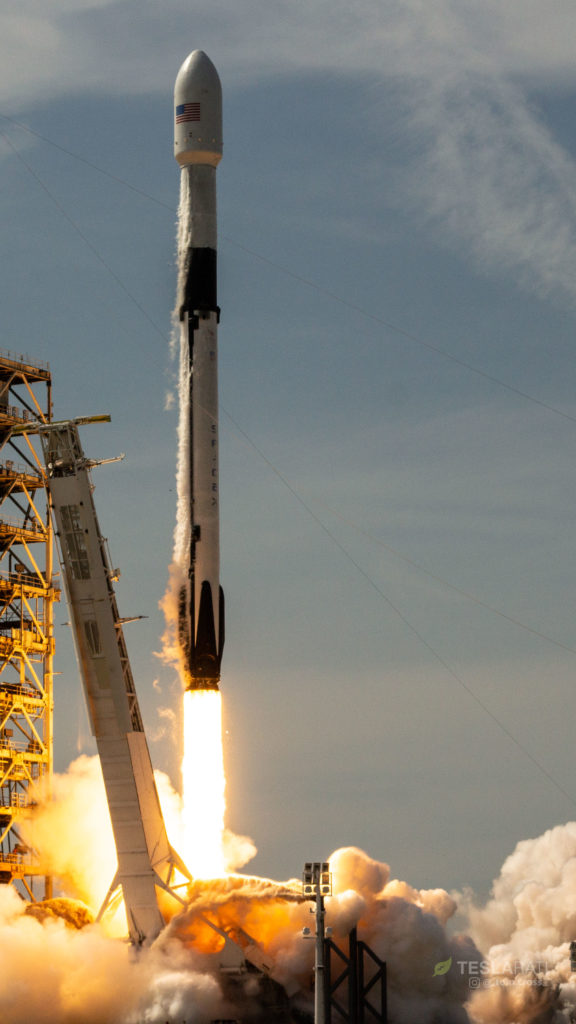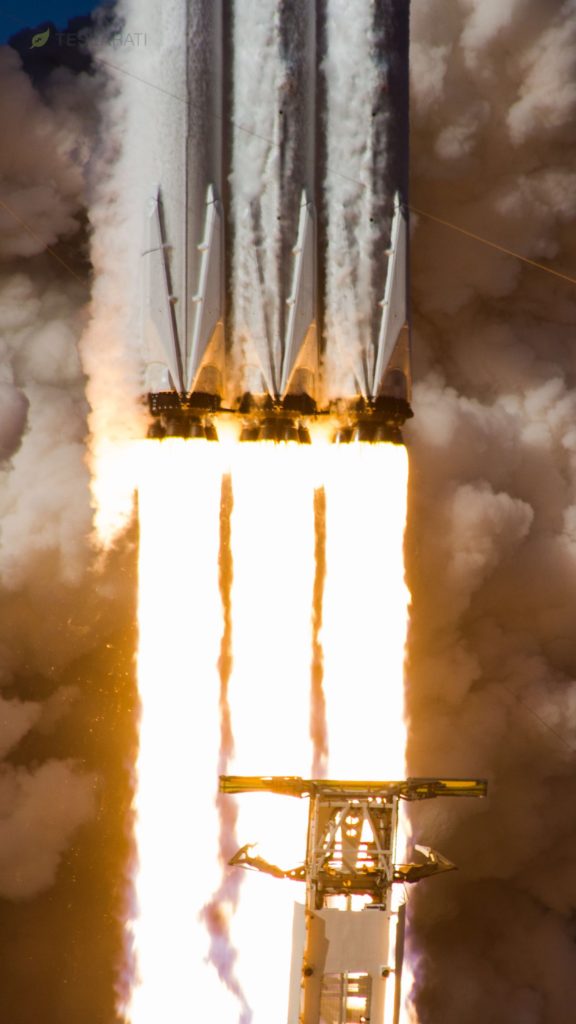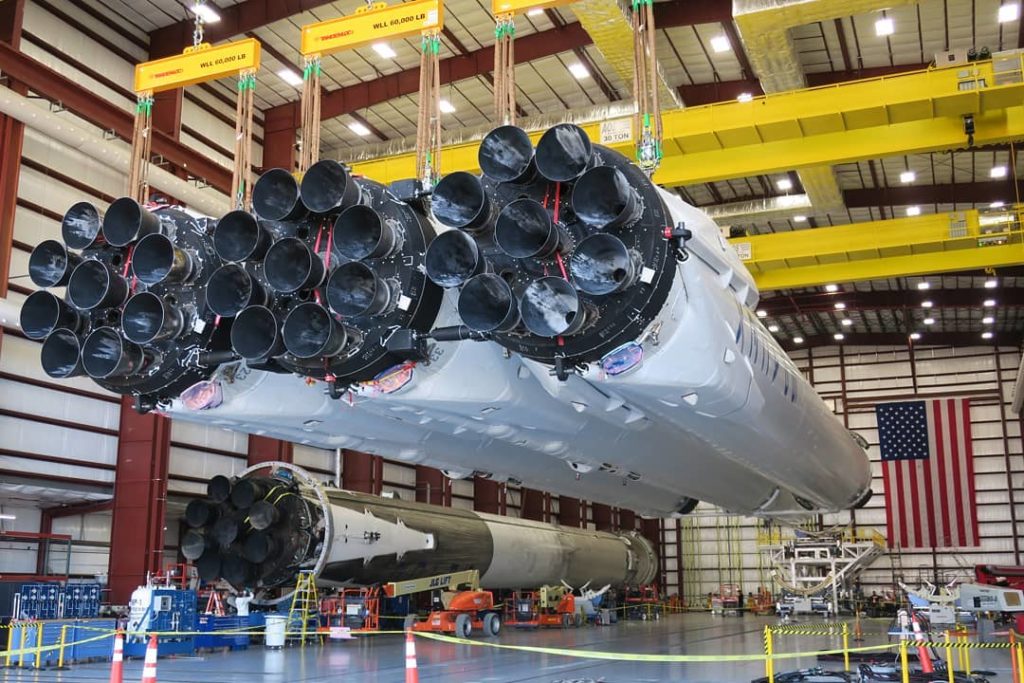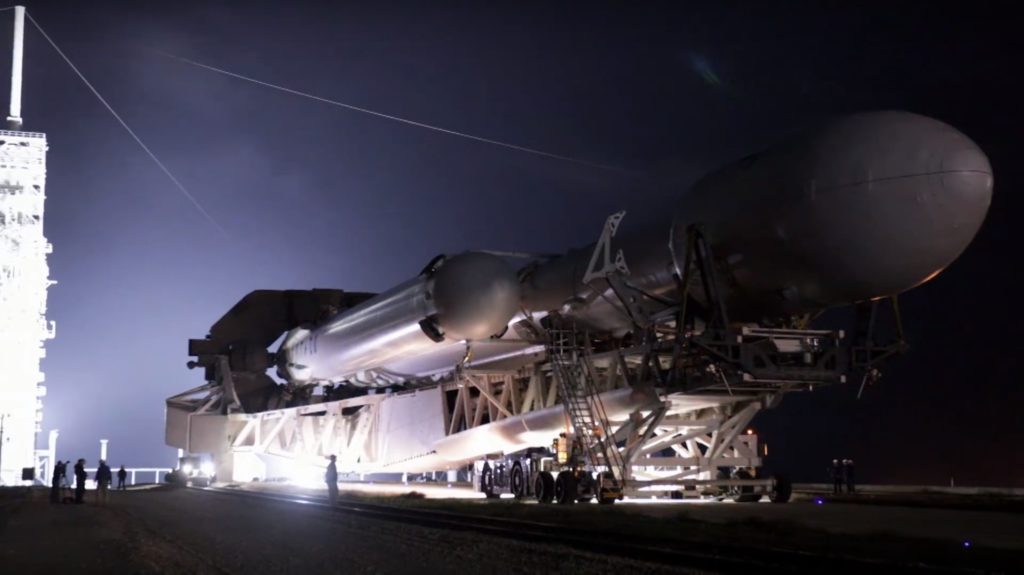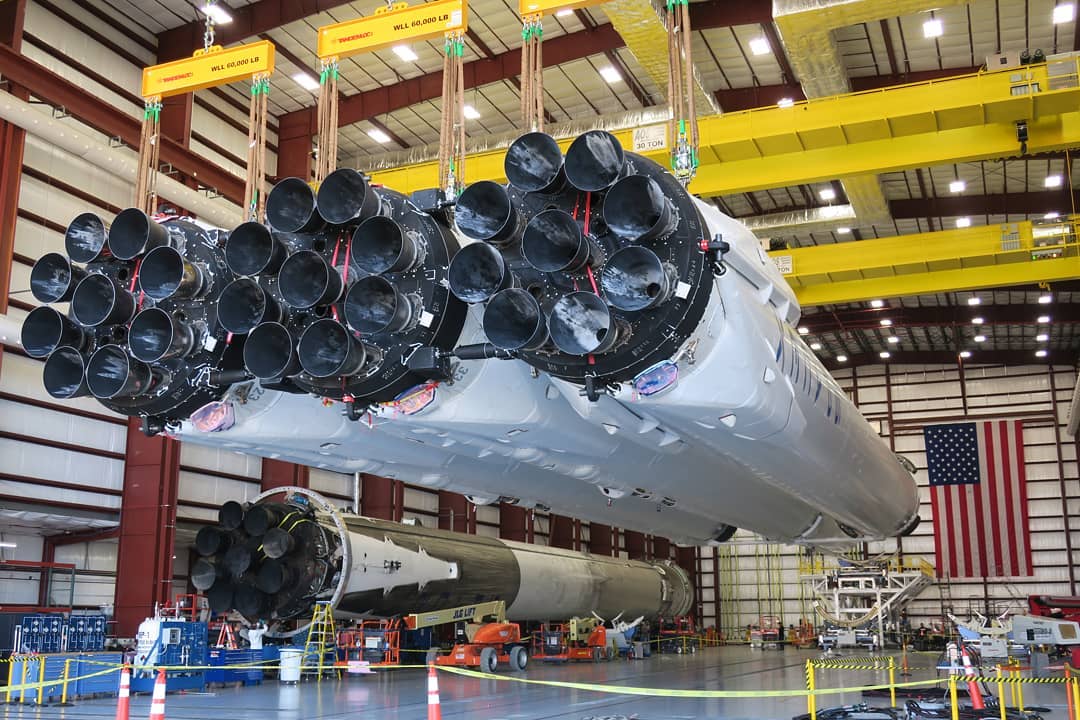
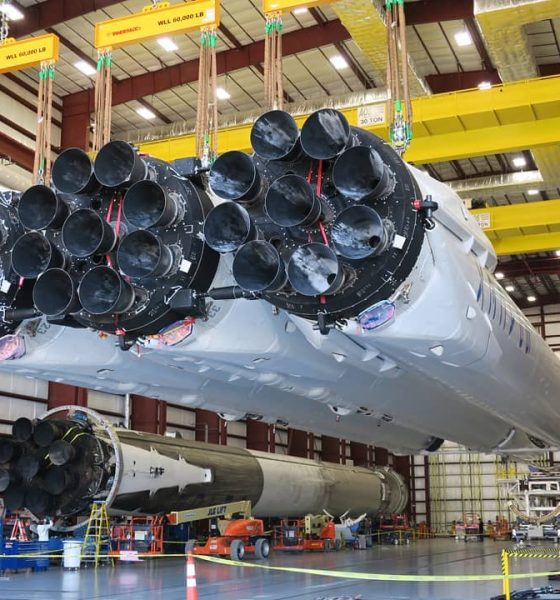
News
SpaceX wins US Air Force contract for Falcon Heavy launch
In an unexpected bode of confidence in the nascent vehicle, SpaceX has competed for and won a $130 million US Air Force launch contract for the massive Falcon Heavy rocket. While not planned to occur until September 2020 at the earliest, the most critical aspect of this development is the fact that the USAF has apparently already certified Falcon Heavy for high-value military launches.
The almost knee-jerk certification of Falcon Heavy for USAF launches makes for an extraordinary contrast when compared with the certification of SpaceX’s Falcon 9 workhorse rocket, a tedious political minefield that took more than two years, led SpaceX to (successfully) sue the federal government, and forced the Air Force to critically reexamine its internal processes after they delayed SpaceX’s certification by six or more months. For that particular endeavor, the USAF required SpaceX to complete three successful Falcon 9 launches, while also preventing SpaceX from engaging in launch contract competitions until their launch vehicle was certified in May 2015.
#SpaceX has won a competitively-awarded #AirForce launch contract for the AFSPC-52 flight. The mission will utilize a #FalconHeavy rocket. Mission will launch by Sept. 2020 from LC-39A at Kennedy Space Center. Statement from Gwynne Shotwell below… pic.twitter.com/a5ka2ov20L
— Chris G (@ChrisG_SpX) June 21, 2018
Jump ahead to 2018 and SpaceX appears to have been allowed to compete for this particular mission – known cryptically as AFSPC-52 – before Falcon Heavy had so much as completed an integrated static fire test. The awe-inspiring rocket did, however, complete a nearly-flawless debut launch in February 2018, a mission that required the company’s Falcon upper stage to survive a lengthy (6+ hour) coast in orbit before igniting its Merlin vacuum engine for one final burn. Regardless of the specifics, many of which have likely been kept under wraps, the Air Force must have been quite impressed with the rocket’s debut performance, and Falcon Heavy has now – according to President and COO Gwynne Shotwell – been certified for USAF missions just four months later.
- Falcon 9 Block 5 completed its first launch on May 11, carrying the Bangabandhu-1 communications satellite to geostationary transfer orbit. (Tom Cross)
- Falcon Heavy clears the top of the strongback in a spectacular fashion. Two of the rocket’s three manifested missions are now for the USAF. (Tom Cross)
It’s somewhere between difficult and impossible to accurately compare the different payloads and launches of the Air Force Space Command (AFSPC), but SpaceX’s only competitor ULA was awarded a contract for the launch of two relatively different AFSPC payloads at an average (fixed) cost of $175 million per mission. Those satellites were likely much smaller than AFSPC-52 but they require direct insertion into geostationary orbit (GEO), whereas AFSPC-52 may instead be sent to a geostationary transfer orbit (GTO) before circularizing the orbit under its own power.
Still, SpaceX’s triple-booster Falcon Heavy launch contract will cost the USAF a slim $130m. It’s worth noting that the 2018 AFSPC-8 and -12 contracts awarded to ULA were for the company’s single-booster Atlas 5 rocket, with most of the draw coming from its admittedly advanced, efficient, and extraordinarily reliable Centaur upper stage, tasked with reigniting repeatedly to circularize the orbit of its valuable satellite payloads once in space.
While it requires far less rigor than the Air Force’s more secretive, national security-sensitive satellite launches, SpaceX’s second Falcon Heavy launch – this time with three highly-reusable Block 5 boosters – will also be conducted with the military branch as the primary customer. Known as Space Test Mission-2 (STP-2), Falcon Heavy will be tasked with carrying a stack of dozens of different smallsats to a variety of orbits. Of note, the vast majority of that mission’s payload comes in the form of a 5000-kilogram ballast mass, included because the mission was manifested on Falcon Heavy (instead of the operational Falcon 9) for the sole purpose of facilitating the rocket’s rapid certification for critical Air Force missions.
- Falcon Heavy may look for more condensed than Delta Heavy, but its performance dramatically outclasses the ULA rocket in all but the highest-energy mission profiles. (SpaceX)
- The fully-integrated Falcon Heavy rolls out to Pad 39A. For vertical integration, think of this… but vertical. (SpaceX)
STP-2 is currently scheduled for no earlier than (NET) November 2018, while the third launch of Falcon Heavy – the commercial Arabsat 6A communications satellite – is tentatively targeted for December, although it’s almost guaranteed to slip into Q1 2019.
Follow us for live updates, peeks behind the scenes, and photos from Teslarati’s East and West coast photographers.
Teslarati – Instagram – Twitter
Tom Cross – Twitter
Pauline Acalin – Twitter
Eric Ralph – Twitter

Elon Musk
Elon Musk’s X will start using a Tesla-like software update strategy
The initiative seems designed to accelerate updates to the social media platform, while maintaining maximum transparency.

Elon Musk’s social media platform X will adopt a Tesla-esque approach to software updates for its algorithm.
The initiative seems designed to accelerate updates to the social media platform, while maintaining maximum transparency.
X’s updates to its updates
As per Musk in a post on X, the social media company will be making a new algorithm to determine what organic and advertising posts are recommended to users. These updates would then be repeated every four weeks.
“We will make the new 𝕏 algorithm, including all code used to determine what organic and advertising posts are recommended to users, open source in 7 days. This will be repeated every 4 weeks, with comprehensive developer notes, to help you understand what changed,” Musk wrote in his post.
The initiative somewhat mirrors Tesla’s over-the-air update model, where vehicle software is regularly refined and pushed to users with detailed release notes. This should allow users to better understand the details of X’s every update and foster a healthy feedback loop for the social media platform.
xAI and X
X, formerly Twitter, has been acquired by Elon Musk’s artificial intelligence startup, xAI last year. Since then, xAI has seen a rapid rise in valuation. Following the company’s the company’s upsized $20 billion Series E funding round, estimates now suggest that xAI is worth tens about $230 to $235 billion. That’s several times larger than Tesla when Elon Musk received his controversial 2018 CEO Performance Award.
As per xAI, the Series E funding round attracted a diverse group of investors, including Valor Equity Partners, Stepstone Group, Fidelity Management & Research Company, Qatar Investment Authority, MGX, and Baron Capital Group, among others. Strategic partners NVIDIA and Cisco Investments also continued support for building the world’s largest GPU clusters.
News
Tesla FSD Supervised wins MotorTrend’s Best Driver Assistance Award
The decision marks a notable reversal for the publication from prior years, with judges citing major real-world improvements that pushed Tesla’s latest FSD software ahead of every competing ADAS system.

Tesla’s Full Self-Driving (Supervised) system has been named the best driver-assistance technology on the market, earning top honors at the 2026 MotorTrend Best Tech Awards.
The decision marks a notable reversal for the publication from prior years, with judges citing major real-world improvements that pushed Tesla’s latest FSD software ahead of every competing ADAS system. And it wasn’t even close.
MotorTrend reverses course
MotorTrend awarded Tesla FSD (Supervised) its 2026 Best Tech Driver Assistance title after extensive testing of the latest v14 software. The publication acknowledged that it had previously criticized earlier versions of FSD for erratic behavior and near-miss incidents, ultimately favoring rivals such as GM’s Super Cruise in earlier evaluations.
According to MotorTrend, the newest iteration of FSD resolved many of those shortcomings. Testers said v14 showed far smoother behavior in complex urban scenarios, including unprotected left turns, traffic circles, emergency vehicles, and dense city streets. While the system still requires constant driver supervision, judges concluded that no other advanced driver-assistance system currently matches its breadth of capability.
Unlike rival systems that rely on combinations of cameras, radar, lidar, and mapped highways, Tesla’s FSD operates using a camera-only approach and is capable of driving on city streets, rural roads, and freeways. MotorTrend stated that pure utility, the ability to handle nearly all road types, ultimately separated FSD from competitors like Ford BlueCruise, GM Super Cruise, and BMW’s Highway Assistant.
High cost and high capability
MotorTrend also addressed FSD’s pricing, which remains significantly higher than rival systems. Tesla currently charges $8,000 for a one-time purchase or $99 per month for a subscription, compared with far lower upfront and subscription costs from other automakers. The publication noted that the premium is justified given FSD’s unmatched scope and continuous software evolution.
Safety remained a central focus of the evaluation. While testers reported collision-free operation over thousands of miles, they noted ongoing concerns around FSD’s configurable driving modes, including options that allow aggressive driving and speeds beyond posted limits. MotorTrend emphasized that, like all Level 2 systems, FSD still depends on a fully attentive human driver at all times.
Despite those caveats, the publication concluded that Tesla’s rapid software progress fundamentally reshaped the competitive landscape. For drivers seeking the most capable hands-on driver-assistance system available today, MotorTrend concluded Tesla FSD (Supervised) now stands alone at the top.
News
Elon Musk’s Grokipedia surges to 5.6M articles, almost 79% of English Wikipedia
The explosive growth marks a major milestone for the AI-powered online encyclopedia, which was launched by Elon Musk’s xAI just months ago.

Elon Musk’s Grokipedia has grown to an impressive 5,615,201 articles as of today, closing in on 79% of the English Wikipedia’s current total of 7,119,376 articles.
The explosive growth marks a major milestone for the AI-powered online encyclopedia, which was launched by Elon Musk’s xAI just months ago. Needless to say, it would only be a matter of time before Grokipedia exceeds English Wikipedia in sheer volume.
Grokipedia’s rapid growth
xAI’s vision for Grokipedia emphasizes neutrality, while Grok’s reasoning capabilities allow for fast drafting and fact-checking. When Elon Musk announced the initiative in late September 2025, he noted that Grokipedia would be an improvement to Wikipedia because it would be designed to avoid bias.
At the time, Musk noted that Grokipedia “is a necessary step towards the xAI goal of understanding the Universe.”
Grokipedia was launched in late October, and while xAI was careful to list it only as Version 0.1 at the time, the online encyclopedia immediately earned praise. Wikipedia co-founder Larry Sanger highlighted the project’s innovative approach, noting how it leverages AI to fill knowledge gaps and enable rapid updates. Netizens also observed how Grokipedia tends to present articles in a more objective manner compared to Wikipedia, which is edited by humans.
Elon Musk’s ambitious plans
With 5,615,201 total articles, Grokipedia has now grown to almost 79% of English Wikipedia’s article base. This is incredibly quick, though Grokipedia remains text-only for now. xAI, for its part, has now updated the online encyclopedia’s iteration to v0.2.
Elon Musk has shared bold ideas for Grokipedia, including sending a record of the entire knowledge base to space as part of xAI’s mission to preserve and expand human understanding. At some point, Musk stated that Grokipedia will be renamed to Encyclopedia Galactica, and it will be sent to the cosmos.
“When Grokipedia is good enough (long way to go), we will change the name to Encyclopedia Galactica. It will be an open source distillation of all knowledge, including audio, images and video. Join xAI to help build the sci-fi version of the Library of Alexandria!” Musk wrote, adding in a later post that “Copies will be etched in stone and sent to the Moon, Mars and beyond. This time, it will not be lost.”
